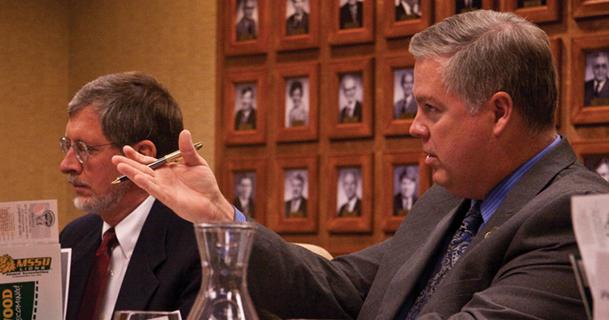Down, but not out
Vice President of Student Affairs Darren Fullerton discusses issues with the rest of the board at the Board of Governors meeting Sept. 16.
The department of student affairs, while disappointed in the decline in enrollment, has expressed a feeling of relief this week as the drop in student enrollment fell below the number they had expected.
A total of 5,591 students are enrolled in classes at Missouri Southern this year, down from 5,802 last year, which means a decrease of 3.63 percent.
“In view of thousands of homes that were destroyed in Joplin, with many families losing loved ones, suffering injuries and experiencing serious damage to homes and property, we are relatively pleased with having less than a 4 percent drop,” Dr. Delores Honey, assistant vice president for assessment and institutional research at Southern said.
Administration officials point out that while a loss of over 200 students may seem to be a substantial loss, the administration had projected a decrease of six to eight percent, and overall was pleased with the outcome.
But at other nearby campuses, enrollment is remarkably up, adding hundreds of new students, while Southern has lost students.
Enrollment at Crowder College in Neosho was up 3.66 percent, and the campus has added faculty.
“We’ve been growing so fast it’s hard to keep up,” Dr. Alan Marble, president of Crowder, told the Neosho Daily-News Wednesday.
Many factors affected Southern’s enrollment, University officials say, including the May 22 tornado that devastated part of the town, as well as recent tuition hikes.
“The last time tuition was raised, we suffered a decline of 300 students,” Dr. Darren Fullerton, vice president of student affairs said. “The perception of Joplin to outsiders, because of the disaster, affected enrollment.”
To confront this, the University hosted a “one-stop” enrollment open house in July, designed to ease enrollment for individuals affected by the storm, or help calm those skeptical of Joplin after the tornado.
Fullerton said some students who had been traveling from out of state, and even international students, expressed concerns with the area recovering, and decided not to attend due to the circumstances.
With all the deterrents in place, the staff at Southern worked vigorously over the summer in an effort to reach out to students who had expressed an interest in the University.
The admissions office said they called and e-mailed students, trying to give them enough time to complete the lengthy financial aid process and also to make sure they were enrolled in all their desired classes by the deadline.
The financial aid department even created a student assistance form, found on the school’s website, to gauge the needs of students.
The University was lauded by the Federal Emergency Management Agency for its response to the disaster.
Though the University didn’t sustain physical damage, there was an emotional toll.
Some students and faculty were among the hundreds of Joplin residents who lost their homes in the May tornado.
In immediate response, the campus opened up to victims — residence halls for rescue workers, the Leggett & Platt Athletic Center turned into a mass shelter area, and the Billingsly Student Center served as location for volunteers to congregate.
“MSSU has done wonders in helping the Joplin community get back on its feet,” Federal Coordinating Officer Mike Karl of the Federal Emergency Management Agency said. “They set a wonderful example of how a community should pull together after devastation. They received no direct damage, but they were the perfect neighbor to Joplin survivors.”
In an effort to offset problems caused by loss of housing, the administration allowed those affected to stay on campus in the residence halls free of charge. The school also worked with FEMA to make sure that community members were aware of deadlines for government assistance.
Southern also had financial aid partners like USA Funds, a private loan company that donated $1,500 to the school to help take care of students who may be waiting on government assistance or insurance money, but needed cash at the time.
In the past, some students have experienced problems with their enrollment, being dropped because of financial aid, missed deadlines or miscommunications between advisors and the admissions office. The admissions office argues these are all easy fixes.
“I urge students who are experiencing these problems to contact us as soon as possible; there is usually a very quick remedy,” Fullerton said.
Missouri enrollment numbers
Fall semester 2011
UCM 11,568 +0.2% NWMSU 7,150 — UMKC 13,586 +0.56% SEMSU 11,510 +3.6% MSSU 5,591 -3.6%
Your donation will support the student journalists of Missouri Southern State University. Your contribution will allow us to purchase equipment and cover our annual website hosting costs.
















